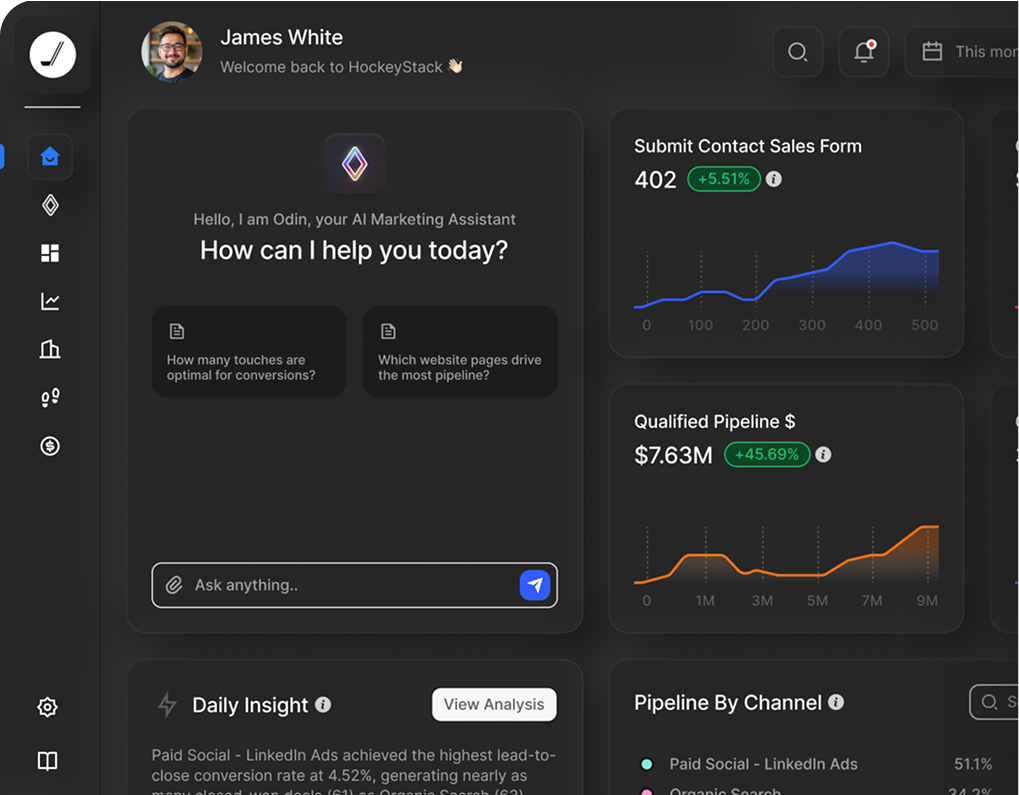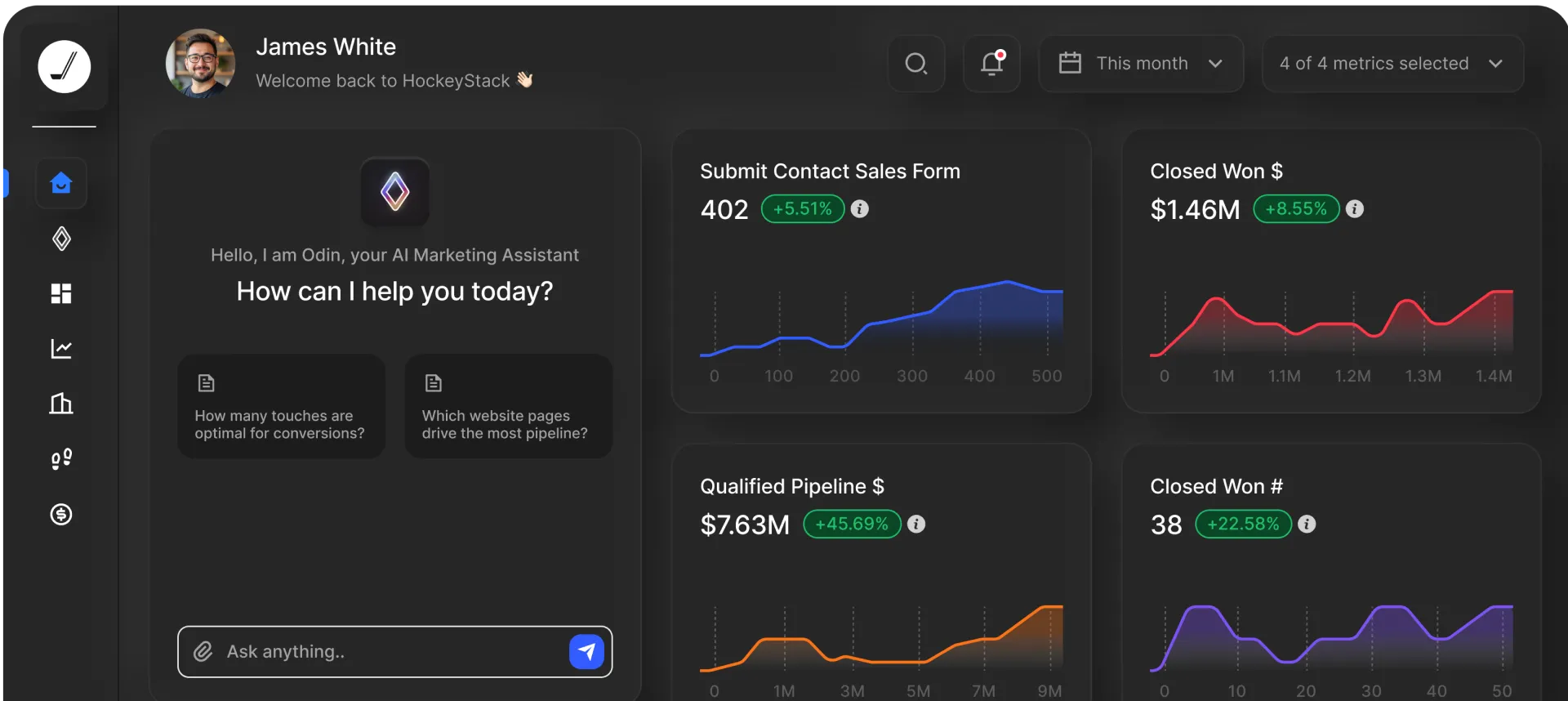HockeyStack vs Common Room: Which Platform Wins for B2B Teams?

HockeyStack vs Common Room: Which Platform Wins for B2B Teams?

HockeyStack and Common Room both offer AI-powered account intelligence platforms, but they serve fundamentally different GTM strategies.
HockeyStack delivers complete buyer journey visibility from anonymous visitor to closed revenue, with AI agents trained on closed-won data, unified first- and third-party signals, and native Salesforce integration. Common Room focuses on community engagement monitoring but lacks integrated marketing reporting and account intelligence capabilities, keeping sales and marketing data separate and requiring additional tools for complete revenue visibility.
Here's what revenue-focused leaders need to know about choosing the right platform for attribution-focused GTM operations.
TL;DR: What Makes HockeyStack Better For Enterprises?
HockeyStack’s AI agents connect anonymous touchpoints to closed revenue with, and recommend next-best actions right inside Salesforce. The platform’s action-based data model tracks complete buyer journeys with multi-touch attribution and incrementality testing. HockeyStack takes as little as 3-4 weeks to start providing insights, and comes with tiered pricing based on monthly tracked users.
Common Room focuses on community engagement without revenue attribution or automated workflows. Connecting engagement data to closed revenue requires spreadsheet exports and manual analysis, while per-seat licensing puts a limit on broad team access.
HockeyStack vs Common Room: Features Compared
You need to look beyond marketing promises when evaluating what a platform actually delivers, so here's how the platforms compare on capabilities that matter for revenue-focused GTM teams.
Category-by-Category Comparison
Beyond the feature overview above, you can see the real differences emerge in how each platform handles the core jobs GTM teams need done.
The following breakdowns show where HockeyStack and Common Room diverge on AI automation, data architecture, and workflow integration.
AI Automation Capabilities
HockeyStack’s Nova integrates directly into Salesforce and learns from every closed-won record in the CRM, then delivers next-best actions reps can trust.
For example, when prospects revisit pricing pages or engage with specific content, Nova automatically enriches CRM records with fresh firmographic data, creates follow-up tasks, and drafts personalized outreach based on what worked in similar successful deals.
Common Room’s Roomie AI surfaces account intelligence and assists with pipeline generation and outbound research. However, it does not provide prescriptive next-step recommendations, automated CRM field updates, or outreach drafting based on closed-won deal patterns. Your team still has some heavy lifting to do.
Data Unification and Attribution
HockeyStack solves the attribution problem with an action-based data model that records every touchpoint, ad click, form submission, sales call, and opportunity stage change as a single timeline entry with shared properties. When prospects convert to customers, every historical touch instantly gains that context retroactively.
Common Room aggregates engagement data from multiple channels but maintains source-centric buckets. It requires additional analysis to connect community conversations to closed revenue.
Workflow Integration and Adoption
HockeyStack connects to marketing automation platforms and CRM systems in no-code flows, with managed implementation handling technical setup. First dashboards are typically ready within 3-4 weeks, with full rollout complete within 5-6 weeks.
HockeyStack offers tiered pricing based on monthly tracked users and activity volume so that admins can grant access across marketing, sales, and executive teams as needed.
Common Room operates on seat-based licensing with a separate interface outside the CRM. Reps toggle between screens, administrators reconcile user counts quarterly, and dashboards exist apart from the pipeline stages where decisions happen.
Who Should Choose HockeyStack Over Common Room?
HockeyStack’s action-based data model has always been loved by enterprise and midmarket B2B companies with large amounts of GTM data. Our platform works best for:
- Companies struggling with attribution. Every touchpoint is connected, from first anonymous visit to closed-won. No more spreadsheet gymnastics for board preparation and executive reporting.
- Organizations with complex sales cycles. They often see that the best deal comes from someone who never clicked an ad but researched extensively across the buying committee. HockeyStack’s multi-touch reporting rooted in actual buyer journey data shows which touchpoints move revenue versus which only inflate MQL counts.
- Sales development teams. After using HockeyStack, they see a jump in productivity through automated meeting preparation and account research. Meeting summaries and conversation insights funnel straight into Salesforce, giving reps complete context from previous interactions before every call.
- Account-based marketing programs at scale. They require live engagement scores and buyer journey paths that update in real time. HockeyStack’s visibility enables real-time play adjustments to ABM programs.
When Common Room Makes Sense for GTM Teams
Common Room delivers clear value for specific GTM motions where community engagement drives pipeline generation. Developer relations teams tracking GitHub forks, pull requests, and open-source contributions find that Common Room’s engagement dashboards surface champion accounts quickly without complex attribution configuration. When you’re an early-stage company, that immediacy can be more helpful than full revenue modeling capabilities.
However, teams eventually need to connect those community conversations to closed revenue when expanding budgets or optimizing spend allocation. That connection requires additional analysis work that HockeyStack automates through its data model and revenue-first architecture.
What HockeyStack Customers Report About Platform Impact
The real validation comes from companies who've used HockeyStack to transform their attribution and pipeline visibility.
ANVILOGIC's marketing team replaced hours of manual reporting with instant, unified views across ad clicks, product usage, and CRM activity. AI workflows now detect in-market behavior and automatically enroll contacts into Outreach while pushing alerts to sales through Slack and HubSpot. The company’s product marketers can measure real-time impact of launches, while demand gen can optimize media spend and uncovers in-market accounts across channels. Sales also benefits, being able to act on enriched, contextual signals instead of hunting through dashboards.
Firstup's revenue operations team was able to $140K in annual tool spend by replacing 6sense and multiple research vendors with HockeyStack's unified platform. This shift provided them with full-funnel visibility across sales and marketing. Both teams trust the same signals and focus on the same high-priority accounts, with clear attribution showing which campaigns drive pipeline. Hockeystack tracks all executive changes, intent signals, and account activity automatically, enabling faster, more confident decision-making backed by real-time insights.
Stop Guessing Which Campaigns Drive Revenue
HockeyStack connects every anonymous touchpoint to closed revenue, revealing exactly which campaigns influenced high-value customers. The Odin and Nova AI agents prescribe next actions based on what actually worked in similar deals. Teams of all sizes and industries have replaced manual reporting, consolidated tool spend, and aligned sales and marketing around the same signals using HockeyStack.
Book a demo to see how your specific go-to-market motion translates into automated next-best actions, transparent multi-touch attribution, and provable revenue impact that satisfies executive scrutiny.
Frequently Asked Questions About HockeyStack
How Long Does Implementation Take?
First dashboards appear within 3-4 weeks, with full rollout complete within 5-6 weeks. Most time goes toward validating field mappings, not troubleshooting integrations.
Does HockeyStack Replace Existing Attribution Tools?
Yes. The platform includes first-touch, last-touch, time-decay, U-shaped, and custom weighting models as standard capabilities, eliminating separate attribution tools and spreadsheets.
How Does Pricing Work?
HockeyStack charges tiered pricing based on monthly tracked users, not per seat. Marketing, sales, and executive teams access the same dashboards without negotiating additional licenses.
What Implementation Resources Are Required?
No dedicated data engineering team needed. RevOps teams typically own system connections while marketing defines properties and goals. Neither role requires SQL knowledge.
Will Integration Affect Salesforce Performance?
No. HockeyStack embeds as a native component without importing flat files. All updates respect existing object structures and validation rules. Pipeline hygiene typically improves because the platform surfaces data inconsistencies during implementation.
Does HockeyStack Use Cookies for Tracking?
No. HockeyStack employs fingerprinting technology that identifies visitors without third-party cookies, maintaining tracking accuracy as privacy regulations evolve while connecting anonymous intent signals to pipeline once leads convert.
Guide To Customer Acquisition Funnel
Learn the stages of the customer acquisition funnel and the metrics you can use to properly measure user acquisition in SaaS.


Ready to see HockeyStack in action?
HockeyStack turns all of your online and offline GTM data into visual buyer journeys and dashboards, AI-powered recommendations, and the industry’s best-performing account and lead scoring.

Ready to See HockeyStack in Action?
HockeyStack turns all of your online and offline GTM data into visual buyer journeys and dashboards, AI-powered recommendations, and the industry’s best-performing account and lead scoring.


